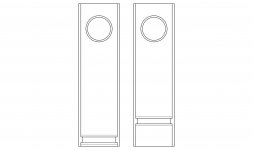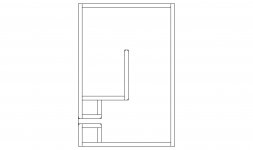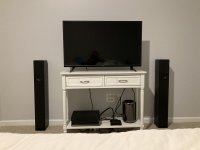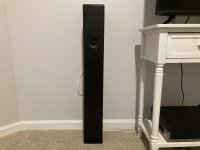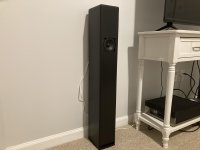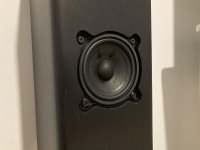So, I'm doing some sketching this morning. Thinking about the possibility the build my TABAQ on a baseplate (or foot) for 1) reduce risk of tipping 2) increase the height with maybe an inch or so and 3) create a room for BSC underneath that is fairly easy accessible. But would this change sound? Reduce low end response?
So, I'm doing some sketching this morning. Thinking about the possibility the build my TABAQ on a baseplate (or foot) for 1) reduce risk of tipping 2) increase the height with maybe an inch or so and 3) create a room for BSC underneath that is fairly easy accessible. But would this change sound? Reduce low end response?
You can do basic experiment: take any speaker, preferably reasonable size, with any type of the vent which is close to the speaker side, and place the speaker on the ground near the wall. Vent has to be close to the ground as in TABAQ, rotate if necessary. Play some music. Now raise speaker higher, 10,20,30cm, or whatever you want by putting speaker on the box, which will simulate your stand. I use kitchen chairs, books and cardboard boxes. Play the same music as before. There should be little bit less bass.
There should be difference, but how much depends on many conditions. Personally think that smth like 5cm in your case will make difference, but not that much to change the overall signature. 30cm will be far different.
Maybe filter built into back plate will work better?
As an experiment, I changed the height of my TABAQs.
Now, directly on the floor, I have 2 places the frequencies dip.
One at 200Hz, and one at 400Hz.
I raised the Tabaqs to 15cm. It flattened out the 400Hz dip quite well, but the 200Hz was still there.
I went nuts and raised the enclosure to 50cm. The 400Hz stayed pretty much the same as at 15cm, and it barely moved at 200Hz, so that one is probably room related.
So, made another experiment with the enclosure raised by 15cm, and the mic 50cm above regular listening position.
I got an almost completely flat FR. Cool.
So, you can also experiment if you wish. Raise the TABAQs by 15cm, and put a 50cm platform under your sofa or couch!
Now, directly on the floor, I have 2 places the frequencies dip.
One at 200Hz, and one at 400Hz.
I raised the Tabaqs to 15cm. It flattened out the 400Hz dip quite well, but the 200Hz was still there.
I went nuts and raised the enclosure to 50cm. The 400Hz stayed pretty much the same as at 15cm, and it barely moved at 200Hz, so that one is probably room related.
So, made another experiment with the enclosure raised by 15cm, and the mic 50cm above regular listening position.
I got an almost completely flat FR. Cool.
So, you can also experiment if you wish. Raise the TABAQs by 15cm, and put a 50cm platform under your sofa or couch!
At risk of upsetting the apple cart here...
Turn the vent vertical. It will raise the driver the length of the vent, and allow room for BSC circuit behind the vent.
The vent already has a 90 degree bend, as designed it's at the beginning of the vent. Turning the vent would put the bend at the end of the vent, but resistance shouldn't change appreciably.
???
Turn the vent vertical. It will raise the driver the length of the vent, and allow room for BSC circuit behind the vent.
The vent already has a 90 degree bend, as designed it's at the beginning of the vent. Turning the vent would put the bend at the end of the vent, but resistance shouldn't change appreciably.
???
'Sounds' like setting on the floor with a solid wedge to tilt it back might be the cure.
GM
Things to try tomorrow!
And no big changes in the lowest end then I presume?
Yep, no change besides a flatter FR line instead of a peak at tuning, a drop, a rise, a drop, then settling....
Any news about that? Cant find changed posts.That would be great and the best idea. 1st post, updated pdfs
As an experiment, I changed the height of my TABAQs.
Now, directly on the floor, I have 2 places the frequencies dip.
One at 200Hz, and one at 400Hz.
I raised the Tabaqs to 15cm. It flattened out the 400Hz dip quite well, but the 200Hz was still there.
I went nuts and raised the enclosure to 50cm. The 400Hz stayed pretty much the same as at 15cm, and it barely moved at 200Hz, so that one is probably room related.
So, made another experiment with the enclosure raised by 15cm, and the mic 50cm above regular listening position.
I got an almost completely flat FR. Cool.
So, you can also experiment if you wish. Raise the TABAQs by 15cm, and put a 50cm platform under your sofa or couch!
How much the sounds of 40-100Hz changed in your listening position? In my room if one of the speakers is in the same place, no matter what the height, most of the bass "travels" to the nearest corner (checked in the head level only) Interestingly in the opposite corner, which is ~0.5m further from the other side speaker there is no bass spike.
Translating to nothing........ Per the chart, a shelf vent has a 2.227 'pipe' end correction, though without access to my own calculator based on measurements, not on pipe end corrections per se, I can't say how accurate it is other than it's my understanding that the chart has been vetted/well proven by others, both pro and DIY.
Re when does a reflex, which is presumed to have a uniform particle density air mass 'plug', change to a 1/4 WL resonator [MLTL, etc.], is when simmed using accurate pipe/horn theory, the 'visible' and/or measured turnover point is when the reflex calculated alignment is 'stretched' to a high enough aspect ratio [pipe compression ratio [CR] to my way of viewing it] that the vent is becoming too long for a given vent area [Av], i.e tuning [Fb, Fp] is 'creeping' lower due to increasing 1/4 WL pipe action increasingly damping the vent with increasing CR.
I currently only have Hornresp
loaded, which has no shelf vent option and otherwise WRT accuracy only know that it's good enough when the vent is a reflex [hole in a box], be it just a box or some type of MLTL and one pipe vent MLTL recently done by 'Scottmoose' in MJK's software for comparison.
All that said, historically it was recommended to start with too large and or too long a vent and do final tuning in-room and IME, many times I had to tune each cab individually for best overall in room performance; though admittedly I'm from the era of 'acoustic solutions to acoustic problems' since highest practical acoustic efficiency was a primary goal, whereas today with ~affordable, high SQ, all encompassing DSP, cheap high power; speaker design has become mostly moot in [casual] DIY, consumer HIFI/HT apps.
GM
Dear GM,
It may be my language barrier, but... Are you talking about personal calculator, which differs a little from the publicly known formulas?
Or there is another things to consider vent tuning, when building MLTL?
Both???
So, tilting works fine.
I have the SB65 pushed back 15cm from a plumb line aimed at the base.
It is also great to better time align the woofer to the full range.
Nas, as I have stated, only the frequencies higher than 200Hz were affected, anything under, I guess the wavelengths are just too great to be affected by such a small change.
That room has bass traps in all 4 corners, but I still get dips and peaks in the lower frequencies if I move around the room.
I have the SB65 pushed back 15cm from a plumb line aimed at the base.
It is also great to better time align the woofer to the full range.
Nas, as I have stated, only the frequencies higher than 200Hz were affected, anything under, I guess the wavelengths are just too great to be affected by such a small change.
That room has bass traps in all 4 corners, but I still get dips and peaks in the lower frequencies if I move around the room.
I kinda finished my speakers. The binding posts aren’t oriented correctly on a couple (ridiculous mistake). So I will probably open back up and fix. This design is the vertical port using a brick inside the reservoir to weigh down. It took forever, though I was adhering to mm level precision. At one point I dropped a 3/4 assembled speaker, essentially knocking it over onto a concrete floor. The darn thing tried exploding on the top of the side facing up. Luckily it split along the joint. Glueing back together solved it. I may add cloth to entire speaker... or not.
I’m letting them break in. The speakers are plenty loud with sufficient bass for my tastes/circumstance. I’ve only had a set of B&O RL 60.2’s in the same system. The B&O’s has more slam due to actual woofer. Though they had a poor sound stage and required placement at ear level for listening. These babies lack the slam but soundstage far better. The midrange doesn’t compare with a Maggie. I’m wondering what more or less stuffing might do. I will only open back up once more, anything more is asking for trouble.
I’m letting them break in. The speakers are plenty loud with sufficient bass for my tastes/circumstance. I’ve only had a set of B&O RL 60.2’s in the same system. The B&O’s has more slam due to actual woofer. Though they had a poor sound stage and required placement at ear level for listening. These babies lack the slam but soundstage far better. The midrange doesn’t compare with a Maggie. I’m wondering what more or less stuffing might do. I will only open back up once more, anything more is asking for trouble.
Attachments
Last edited:
They came out beautiful irishpatrick - despite some mishaps. I like the rounded corners and the rebates for the drivers are perfect. CNC I assume, or some excellent router skills. Hope you enjoy them more after the drivers have loosed their muscles a bit. Are you using a BSC?
Rebating a Faital driver is certainly not the easiest.
The rounded corners are indeed quite nice, too.
Because you are the builder, only you will notice the little flaws. Everybody else will marvel at these.
You will indeed need a BSC with them, if you hadn't already.
It would bring back the midrange and bass slam that a 3" driver can provide!
Enjoy!
The rounded corners are indeed quite nice, too.
Because you are the builder, only you will notice the little flaws. Everybody else will marvel at these.
You will indeed need a BSC with them, if you hadn't already.
It would bring back the midrange and bass slam that a 3" driver can provide!
Enjoy!
BSC = Baffle Step Compensation (or circuit). To use Bjorn's own words from one of his documents:
TABAQ in your listening room
Until now, I have been is the world of theory. Real life is different, and I have to deal with the baffle step problem, which is general for all full range designs.
You already know than a speaker placed in the middle of the room has a weaker bass then placed against the wall. The same thing is happening for the middle and high tones, which get extra help from the front of the cabinet. The result is a speaker that sounds bright with a focused middle tone. This “analytical” sound will be irritating after some time.
Therefore, a baffle step compensation circuit is needed to attenuate the higher frequencies.
Does it sound complicated? It is not. It is just a resistor and an inductor in parallel and placed in the + cable to the driver.
Martin King latest MathCad models now include calculations needed for baffle step compensation. The values for the TABAQ are a resistor of 3.9 Ohm and an inductor of 1.0 mH. This is 4 db attenuation at 700 Hz. If your cabinet is more than 1 meter from the wall – or your personal choice would prefer more attenuation of the higher frequencies, 6 db attenuation is accomplished by using 6.8 ohm and 1.5 mH instead.
TABAQ in your listening room
Until now, I have been is the world of theory. Real life is different, and I have to deal with the baffle step problem, which is general for all full range designs.
You already know than a speaker placed in the middle of the room has a weaker bass then placed against the wall. The same thing is happening for the middle and high tones, which get extra help from the front of the cabinet. The result is a speaker that sounds bright with a focused middle tone. This “analytical” sound will be irritating after some time.
Therefore, a baffle step compensation circuit is needed to attenuate the higher frequencies.
Does it sound complicated? It is not. It is just a resistor and an inductor in parallel and placed in the + cable to the driver.
Martin King latest MathCad models now include calculations needed for baffle step compensation. The values for the TABAQ are a resistor of 3.9 Ohm and an inductor of 1.0 mH. This is 4 db attenuation at 700 Hz. If your cabinet is more than 1 meter from the wall – or your personal choice would prefer more attenuation of the higher frequencies, 6 db attenuation is accomplished by using 6.8 ohm and 1.5 mH instead.
I kinda finished my speakers. The binding posts aren’t oriented correctly on a couple (ridiculous mistake). So I will probably open back up and fix. This design is the vertical port using a brick inside the reservoir to weigh down. It took forever, though I was adhering to mm level precision. At one point I dropped a 3/4 assembled speaker, essentially knocking it over onto a concrete floor. The darn thing tried exploding on the top of the side facing up. Luckily it split along the joint. Glueing back together solved it. I may add cloth to entire speaker... or not.
I’m letting them break in. The speakers are plenty loud with sufficient bass for my tastes/circumstance. I’ve only had a set of B&O RL 60.2’s in the same system. The B&O’s has more slam due to actual woofer. Though they had a poor sound stage and required placement at ear level for listening. These babies lack the slam but soundstage far better. The midrange doesn’t compare with a Maggie. I’m wondering what more or less stuffing might do. I will only open back up once more, anything more is asking for trouble.
wowww they are simply gorgeous love it

I kinda finished my speakers. The binding posts aren’t oriented correctly on a couple (ridiculous mistake). So I will probably open back up and fix. This design is the vertical port using a brick inside the reservoir to weigh down. It took forever, though I was adhering to mm level precision. At one point I dropped a 3/4 assembled speaker, essentially knocking it over onto a concrete floor. The darn thing tried exploding on the top of the side facing up. Luckily it split along the joint. Glueing back together solved it. I may add cloth to entire speaker... or not.
I’m letting them break in. The speakers are plenty loud with sufficient bass for my tastes/circumstance. I’ve only had a set of B&O RL 60.2’s in the same system. The B&O’s has more slam due to actual woofer. Though they had a poor sound stage and required placement at ear level for listening. These babies lack the slam but soundstage far better. The midrange doesn’t compare with a Maggie. I’m wondering what more or less stuffing might do. I will only open back up once more, anything more is asking for trouble.
Kudos for implementation. Ascetic but very very solid and professional. Is this 3fe25 or 3fe22? If you run some test tone from 20Hz to 20kHz when there is "some" bass and when there is "solid" bass? Are they suitable for 60-65Hz?
- Home
- Loudspeakers
- Full Range
- TABAQ TL for Tangband
